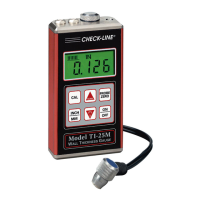– 15 –
6.0CALIBRATION FOR MEASURING THICKNESS OF
MATERIALS OTHER THAN STEEL
Ultrasonic Thickness Gauges use sound waves to measure wall thickness.
Different types of materials have different inherent acoustic velocities. For
instance, the acoustic velocity of steel is 0.2330 IN/µs (inches-per-microsecond),
versus that of aluminum, which is about 0.2500 IN/µs. It is critical that the
TI-25M be set for the correct acoustic velocity depending upon the material to be
measured.
The TI-25M is shipped from the factory calibrated for steel with an acoustic
velocity of 0.2330 IN/µs (5920 M/s). To measure the thickness of
any other
material, the calibration will have to be changed by adjusting the acoustic
velocity to the appropriate value for the specific material being measured.
When checking the thickness of the built-in Test Plate, the gauge should display
the “Equivalent Value” (inches or mm) listed in theAcoustic Velocity Tablein
section 6.1.
To determine the proper acoustic velocity for the non-steel material, refer to the
Acoustic Velocity Table, section 6.1. After determining the proper acoustic
velocity, the gauge must be re-calibrated for this new value as described in
section 6.2 Changing Calibration - Acoustic Velocity Is Known.
If you do not know the type of material to be measured or if the material type is
not listed in the Acoustic Velocity Table, refer to section 6.3, Changing
Calibration - Acoustic Velocity Is Not Known.

